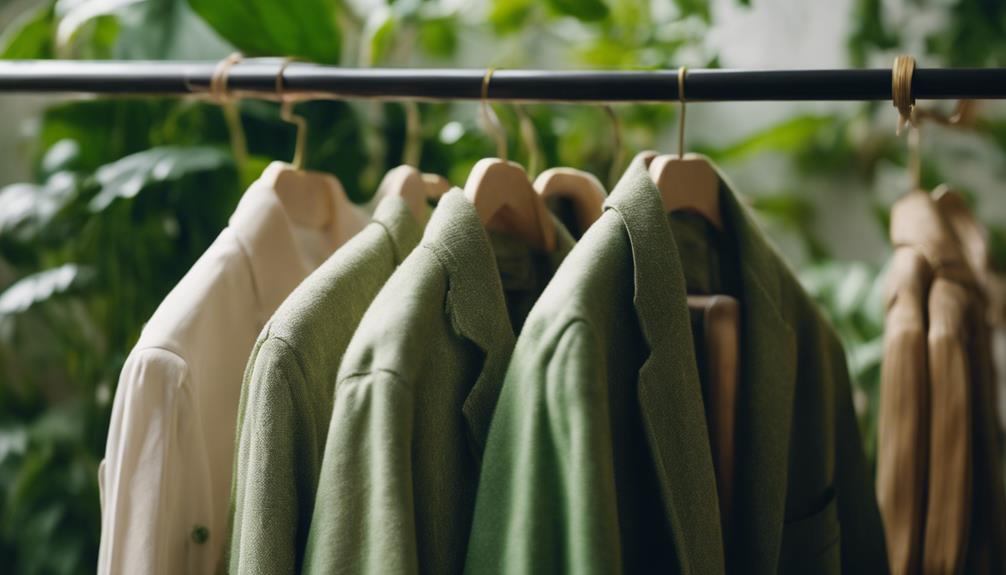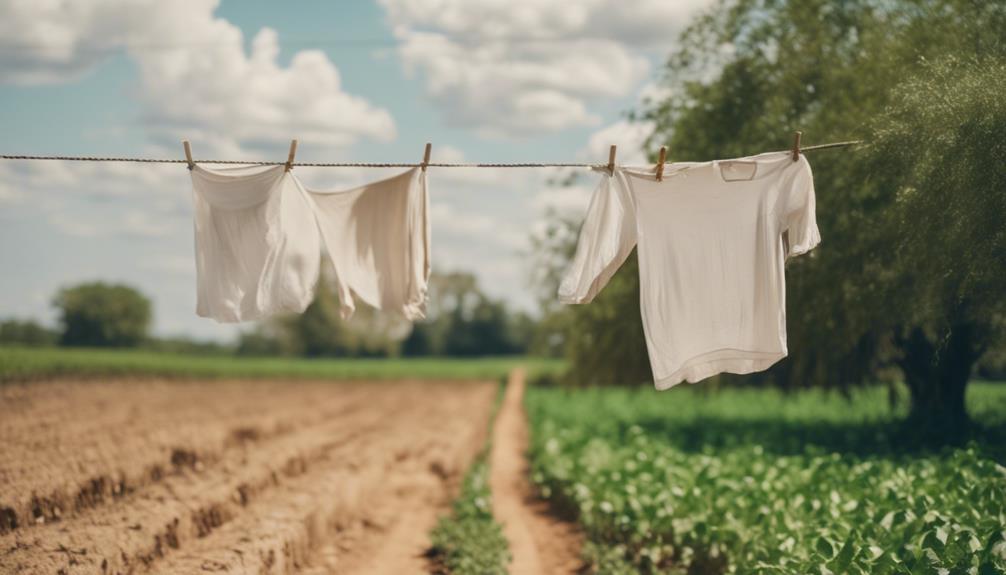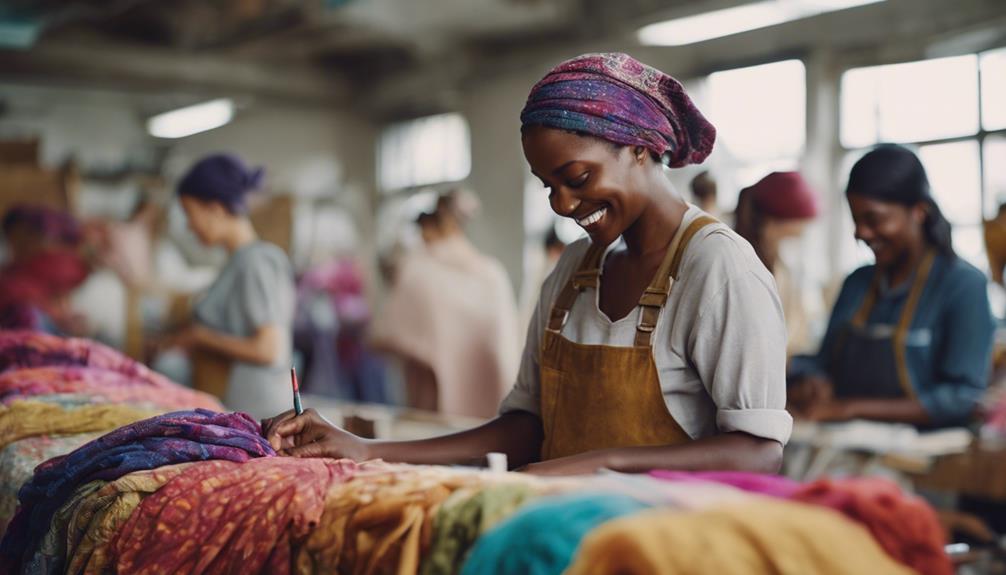When you choose to buy sustainable fashion, you are not only benefiting your wardrobe but also the planet. Sustainable clothing lasts longer, saving you money in the long run. By shopping sustainably, you help reduce carbon emissions and water waste, creating a positive impact on the environment. Moreover, supporting ethical brands means protecting animal lives and ensuring fair labor practices for workers. Investing in high-quality, eco-friendly garments promotes a more responsible fashion industry. If you want to learn more about the amazing benefits of sustainable fashion, there is plenty to explore about its transformative power! Sustainable fashion buyers play a crucial role in driving innovation within the industry. By advocating for eco-friendly materials and production methods, they inspire brands to think innovatively and develop new, sustainable techniques. Furthermore, supporting sustainable fashion sends a clear message to the market that there is a growing demand for environmentally conscious products, potentially leading to increased accessibility and affordability for all consumers. Ultimately, embracing sustainable fashion empowers individuals to make a positive impact and create a more sustainable future. Sustainable fashion buyers also play a key role in fostering innovation within the industry. By demanding eco-friendly materials and production methods, they encourage brands to think creatively and develop new, sustainable techniques. Additionally, supporting sustainable fashion sends a message to the market that there is a growing demand for environmentally conscious products, which can ultimately lead to greater accessibility and affordability for all consumers. Ultimately, embracing sustainable fashion is a powerful way for individuals to make a positive impact and drive change towards a more sustainable future.
Key Takeaways
- Sustainable fashion saves money long-term due to the durability and longevity of high-quality garments.
- It significantly reduces carbon footprints and supports eco-friendly practices, benefiting the environment.
- Local production minimizes transportation emissions and supports community economies, fostering ethical labor practices.
- Choosing sustainable brands promotes cruelty-free practices, protecting animal welfare and ecosystems from harmful chemicals.
Saves Money in the Long Run
When you invest in sustainable fashion, you're not just making an eco-friendly choice; you're also setting yourself up for significant savings over time. While fast fashion brands offer cheap clothes, these items often wear out quickly, leading to a cycle of constant replacement.
In contrast, sustainable clothing is designed for durability, meaning you won't have to repurchase as frequently. By choosing high-quality pieces, you save money in the long run. These sustainable garments maintain their shape and utility through repeated wear, which reduces overall spending on replacements.
When you analyze the costs, it becomes clear that sustainable fashion minimizes textile waste. The average person discards around 37 kg of textiles each year; by opting for better quality, you'll contribute less to this statistic.
Although sustainable clothing may have a higher initial price, the investment pays off over time. You'll find that fewer purchases lead to lower overall spending, making your wardrobe not only more conscientious but also more economical.
High-Quality Clothing

Investing in high-quality clothing not only elevates your wardrobe but also guarantees longevity, reducing the need for frequent replacements. When you choose sustainable fashion, you're opting for durable garments that can last years, unlike fast fashion items that often wear out after just a few months. This commitment to quality means you'll spend less over time, as you won't constantly be buying replacements.
Sustainable fashion is good for both your closet and the planet. Many brands focus on eco-friendly materials that enhance the durability of their products while minimizing environmental impact. By selecting well-crafted items, you contribute to a reduction in textile waste; on average, individuals discard about 37 kg of textiles annually.
For example, brands like Miik prioritize sustainable fabrics that not only extend the life of their clothing but also align with responsible production practices. By investing in high-quality clothing, you're making a conscious choice that benefits your wallet and the environment.
Reduces Carbon Footprint

When you choose sustainable fashion, you're actively reducing your carbon footprint.
By opting for eco-friendly materials and supporting local production, you help lower emissions associated with garment creation.
These conscious choices can make a real difference in combating climate change.
Lower Emission Practices
Adopting sustainable fashion practices greatly cuts carbon emissions, helping to combat the industry's hefty contribution to global warming. The fashion industry is responsible for about 10% of global carbon emissions, with fast fashion alone contributing 1.2 billion tonnes annually. By supporting sustainable brands, you directly participate in lowering carbon footprints. These brands often utilize natural materials that require fewer resources, making their production methods more eco-friendly.
Additionally, local production plays an essential role in reducing emissions. When garments are made closer to home, it minimizes the distances they must travel, considerably lowering transportation emissions. Research shows that the average t-shirt travels around 25,000 kilometers before it reaches your closet. By choosing locally made clothing, you help shrink this number, further contributing to lower emission practices.
Every piece you purchase from eco-friendly brands not only supports sustainable practices but also contributes to carbon offset initiatives. You can make a difference with your shopping choices. By opting for sustainable fashion, you become part of the solution, helping to mitigate the fashion industry's impact on our planet.
Eco-Friendly Material Utilization
Utilizing eco-friendly materials is a key strategy in reducing the fashion industry's carbon footprint and fostering a more sustainable future. By choosing eco-friendly fabrics, you're supporting ethical and sustainable production processes that notably lower carbon emissions. These materials often require fewer resources and less energy than their synthetic counterparts.
Here's a quick comparison of various fabric types and their environmental impact:
| Fabric Type | Carbon Emissions (per kg) | Sustainability Rating |
|---|---|---|
| Organic Cotton | 1.8 kg | High |
| Recycled Polyester | 2.1 kg | Medium |
| Conventional Cotton | 3.0 kg | Low |
| Hemp | 0.5 kg | High |
| Tencel | 1.0 kg | High |
The fashion industry currently contributes about 10% of global carbon emissions, with fast fashion alone generating around 1.2 billion tonnes annually. By opting for brands that prioritize eco-friendly materials, you're not only reducing your carbon footprint but also encouraging a shift towards more responsible practices in the industry. It's a small choice that makes a big impact!
Local Production Benefits
Local production cuts down on carbon emissions by reducing the distance garments have to travel, making a significant impact on sustainability. When you choose sustainable fashion produced locally, you're directly contributing to a decrease in transportation emissions. For instance, the average t-shirt travels an alarming 25,000 kilometers before reaching your closet. By supporting brands that manufacture within your region, you help minimize this journey, effectively lowering carbon emissions.
Additionally, many sustainable brands that focus on local production utilize eco-friendly materials. These materials not only require fewer resources to create but also align with ethical practices, further enhancing their positive environmental impact.
When you invest in locally produced clothing, you're not just making a fashion choice; you're also supporting community economies and promoting fair labor practices.
Saves Animal Lives

When you choose sustainable fashion, you're helping to reduce toxic waste that harms wildlife and ecosystems.
Brands that prioritize cruelty-free practices guarantee that animals aren't subjected to harmful chemicals or exploitation.
Reduces Toxic Waste
Sustainable fashion drastically cuts down on toxic waste, protecting both animal lives and fragile ecosystems. Unlike fast fashion, which relies heavily on toxic chemicals during production, sustainable brands prioritize eco-friendly practices. They use non-toxic dyes and adopt responsible fabric production processes, markedly reducing harmful waste released into our environment.
| Impact of Fashion | Sustainable Solutions |
|---|---|
| 20% of global wastewater from dyeing | Non-toxic dyes used by sustainable brands |
| 35% of ocean microplastic pollution | Environmentally responsible production methods |
| Endangers animal and human health | Preservation of wildlife and habitats |
Promotes Cruelty-Free Practices
Choosing sustainable fashion not only helps reduce toxic waste but also promotes cruelty-free practices that save animal lives by ensuring ethical treatment throughout the production process.
When you opt for sustainable brands, you support companies that prioritize the well-being of animals, ensuring that no harm comes to them during production. These brands often use non-toxic dyes, which not only safeguard animal health but also protect the environment from hazardous chemicals.
Additionally, the conventional fashion industry greatly contributes to global wastewater pollution, which endangers both wildlife and human health. By selecting sustainable options, you help minimize this impact, as these brands employ environmentally-responsible processes that maintain the integrity of animal habitats.
Transparency is another crucial aspect of sustainable fashion; many brands openly share their practices, allowing you to verify that their products are free from animal-derived materials and harmful substances.
This commitment to cruelty-free practices means you can shop with confidence, knowing your choices contribute to a more ethical industry. By choosing sustainable fashion, you're not just making a style statement; you're actively saving lives and promoting a compassionate future for all.
Requires Less Water

The fashion industry's water consumption is staggering, but opting for sustainable brands can considerably reduce this impact. Did you know that producing a single t-shirt consumes around 700 gallons of water? This shocking statistic highlights the significant water waste associated with fast fashion. By choosing sustainable brands, you're not just making a stylish choice; you're also conserving essential water resources.
Sustainable brands prioritize long-lasting materials, which means you'll buy less often, ultimately leading to less water used in clothing production. They also implement water recycling practices, minimizing the amount of fresh water needed during manufacturing. Additionally, these brands employ non-toxic dye processes that further contribute to reduced water usage and pollution compared to traditional methods.
When you shop sustainably, you take a stand against the environmental impact of the fashion industry. Each choice you make helps to conserve water, ensuring we protect this essential resource for future generations.
Supports Safe Working Conditions

By opting for brands that focus on sustainability, you also support safe working conditions for garment workers around the globe. Ethical fashion prioritizes the welfare of these individuals, ensuring they work in environments that aren't only safe but also respectful. Here's how your choices make a difference:
- Fair Wages: Sustainable brands often pay their workers fair wages, moving away from the shocking rates as low as USD 26/month.
- Transparency: When you choose ethical fashion, you're backing brands that maintain transparency about their production processes, making it easier to hold them accountable.
- Safe Working Conditions: Historical incidents, like factory collapses, remind us why oversight is essential. Sustainable brands endeavor to provide secure environments for their workers.
- Local Production: Many sustainable brands produce locally, allowing for direct observation of factory conditions, which fosters greater accountability.
Frequently Asked Questions
What Are the Benefits of Sustainable Fashion?
Sustainable fashion offers you reduced environmental impact, cost savings on durable clothing, ethical labor practices, less textile waste, and healthier ecosystems. By choosing it, you contribute to a more responsible and eco-friendly fashion industry.
Why Should You Shop Sustainable Fashion?
You should shop sustainable fashion because it reduces your carbon footprint, supports ethical labor practices, and promotes eco-friendly materials. By choosing quality over quantity, you save money and help create a healthier planet for everyone.
Why Is Sustainability so Important in Fashion?
Imagine vibrant forests and clear waters fading away; sustainability in fashion fights this reality. It's essential for our planet's health, curbing carbon emissions, conserving water, and promoting fair labor practices—ensuring a brighter future for all.
Why Is It Important to Buy From Sustainable Brands?
It's important to buy from sustainable brands because you support eco-friendly practices, reduce waste, and promote ethical labor conditions. Your choices can considerably lower your environmental impact while encouraging the industry to prioritize sustainability and quality.
Conclusion
When you choose sustainable fashion, you're planting seeds for a better future.
Each piece of clothing becomes a thread in a tapestry of positive change, weaving together savings, quality, and compassion.
As you wear these garments, you're not just showcasing style; you're nurturing the planet and its inhabitants.
So, let your wardrobe reflect your values, and watch as your choices bloom into a vibrant legacy of sustainability, one outfit at a time.









